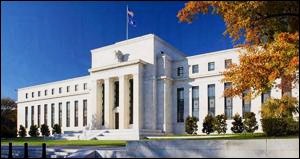By Pam Martens and Russ Martens: August 7, 2019 ~
On July 30, 2019, the day before the U.S. central bank, the Federal Reserve, cut interest rates by one-quarter of one percent, the yield on the 10-year U.S. Treasury note closed the day at 2.06 percent. Early this morning, the yield on the 10-year U.S. Treasury stood at 1.65 percent, a stunning decline of 41 basis points in 8 days. A yield evaporation on U.S. sovereign debt that resembles a snow cone in July is not consistent with a strong economy. It is consistent with a seriously sputtering economy and a stock market out over its skis in terms of valuation.
In addition to the collapsing yield in the benchmark 10-year, we now have a seriously inverted yield curve with the 3-month T-bill yielding 2.01 percent this morning versus the 10-year T-note yielding 1.65 – a difference of 36 basis points.
An inverted yield curve means that investors are gobbling up longer-term Treasury debt (thus driving down its yield) on the expectation that as the economy slows or goes into recession, there will be less demand for money, thus lower inflation, thus ever lower long-term yields to be had; thus it’s better to grab what you can get now.
The yield on the 10-year Treasury may be falling more rapidly than it otherwise would because the Federal Reserve finds itself in the unenviable situation of having a half empty arsenal to manage a future recession or more severe economic upheaval.
When the Fed faced the financial slowdown of 2007 and the epic financial crash of 2008, it started with 5.25 percent interest in its arsenal, allowing it to slash rates by a half-percentage point in September of 2007; another quarter point in October; another quarter point in December; a three-quarter point cut on January 22; another panic cut of a half-point on January 30; another three-quarter point cut on March 18; followed by four more cuts that year that evaporated the Fed Funds rate to the so-called zero-bound range of 0 to 0.25 percent.
The Fed’s rate-cut on July 31 of this year was its first since the financial crisis. It started this easing program from a meager 2.25 to 2.50 percent Fed Funds rate. It now has just 2.00 to 2.25 percent left in its arsenal. Should it need to ease as aggressively as it did in 2008, it would be completely out of bullets in four months’ time. That’s a serious problem because deep recessions or major financial shocks do not end in four months.
During the onset of the last financial crisis the Fed’s arsenal was also not bogged down with a bloated balance sheet of $4 trillion from its gorging on the debt bombs that nobody else would take off the balance sheets of the Wall Street mega banks. That debt simply moved from the mega banks to the Fed’s balance sheet in a polite turn of phrase called Quantitative Easing. And there the debt has remained ever since, minus about $500 billion – which is as far as the Fed got in its efforts to “normalize” its balance sheet before President Donald Trump began to demand Fed easing via his Twitter page.
Equally problematic, the Federal Reserve is not the only central bank facing serious headwinds. There is now $15 trillion in negative-yielding sovereign and corporate debt around the globe. Yes, you read that correctly: the yield is below zero percent interest. As of this morning, here’s a sampling of where things stand: Germany’s 10-year bund is yielding a negative -0.60 percent and Japan’s 10-year is yielding a negative -0.20 percent. Negative yields do not correlate with strong economies or bright economic futures.
Germany is viewed as the economic engine in the Eurozone and a report out this morning is likely to drive yields deeper into negative territory. Germany’s statistics office reported that industrial production there fell in June to a level that is 5.2 percent lower than a year ago.
Germany reports its GDP for the second quarter next week and it is widely expected to report that its economy contracted. That would come on the heels of an almost indiscernible growth of just 0.4 percent in the first quarter.
Other central banks are flashing alarm signals. This morning central banks in India, New Zealand and Thailand cut their interest rates by more than markets were anticipating.
When we started writing this article early this morning, futures on the Dow Jones Industrial Average were in positive territory. As the market edged closer to opening, however, Dow futures dropped almost 300 points.
Adding to the chaos, Donald Trump, was back on his Twitter page this morning before the market opened, bashing the Federal Reserve for “incompetence” and failing to cut rates fast enough to please him.
It’s now 9:37 a.m. and the market has been open for just 7 minutes. The Dow is down 399 points.


